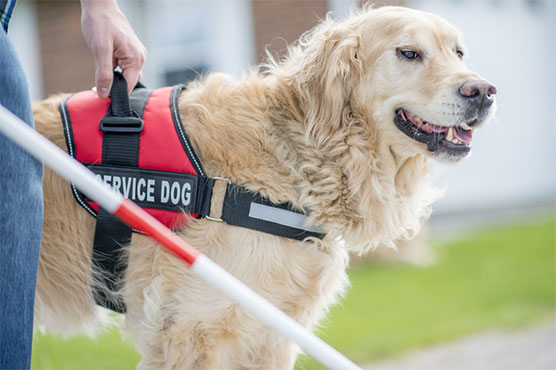Dogs trained to help visually impaired people in everyday routine

The dogs are housed at the school, which has instructors on site 24 hours a day.
ARGENTINA (Reuters) - Twenty-four year old Brenda Martinez Barreto has been blind since birth. As she sits here, talking and laughing with her companions, she waits for her turn to work with Helen, the labrador retriever who is being trained to become her guide dog.
For two years, she and the dog have undergone a carefully managed process at the Argentine Guide Dog School (EGPA), where dedicated trainers follow a curriculum that gradually trains the dog to work with the specific owner.
The first step, explained instructor Maximiliano Araoz, is evaluating the temperament, personality and physical characteristics of each prospective owner to match up with the dog.
"Before they come here, they go through psychological and physical testing. They are also given a complete evaluation of their mobility and -- very important-- an evaluation to determine their degree of sociability, how they handle themselves and their disposition. We use all these basic factors to pre-select the best animal for each person," he said, explaining that an introverted person, for example, would not be matched with a more rambunctious dog.
Because of their temperament and physical characteristics, most of the dogs are labrador or golden retrievers, who have been chosen since shortly after birth to be guide dogs.
The dogs are housed at the school, which has instructors on site 24 hours a day.
There, they undergo intensive individual training inside and outside while the owners attend orientation classes. There are six students in Brenda’s class, all of whom are visually impaired.
Once the dogs can comfortably and reliably handle controlled conditions at the school, the trainers take them into the city, where they are exposed to a variety of situations.
"We work on socialization which is nothing more and nothing less than exposing the animal to different textures, different climates, different scenarios like cars, buses, planes. All the work so that the animal can take on any environment in a natural way and not negatively," said Araoz.
Then the dogs work with their individual owner, who eventually live in dormitories at the school.
Martinez Barreto said she feels much more confident walking down the street with Helen.
"The only thing I do now is feel the handlebar and allow myself to be guided by it and allow it to sidestep whatever it needs to sidestep. I feel this (having the trained guide dog) one hundred percent changes my speed and safety when I walk, even just in the fact that the dog avoids obstacles and sometimes you don’t even find out," she said.
With the dog trainers walking close by, Martinez Barreto and Helen walk down sidewalks, cross streets and enter shops, to make sure the dog not only knows how to handle the environment, but that the owner knows how to respond to the dog.
Martinez Barreto who attends law school and works as a receptionist, said she anticipates Helen will accompany her all day every day.
"I will go everywhere with her: to the university, to my job. Wherever I go, she’ll be with me," she said.
After two years, Martinez Barreto finally took Helen home.
Together, they seamlessly navigated the bus, the busy streets and a local cafeteria before walking into work.
Helen is expected to serve as a guide for 8 years, when she will retire at the age of ten, and stay on as a pet and Martinez Barreto will be given a new guide dog. If at any point a dog is unable to continue serving as a guide-- for example, if the dog were to become to ill to continue, the school will work with owners to replace the dog.
In a country with over 1.2 million visually impaired people, there are only 35 trained guide dogs, according to The Argentine Guide Dog School. In existence for 10 years, EGPA has trained 20 of them.
One of the barriers to increased guide dog use is the cost. With a total fee of $15,000 USD per owner, each guide dog costs almost three times the average income per capita.

